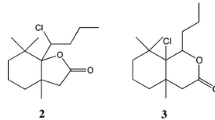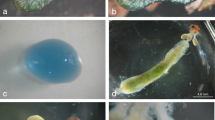Abstract
The parsnip webworm,Depressaria pastinacella, feeds on plants containing high concentrations of furanocoumarins. compounds toxic to many organisms. Parsnip webworm larvae were fed radiolabeled xanthotoxin to quantify the detoxification of this furanocoumarin. They metabolized approximately 95% of the ingested xanthotoxin, indicating that metabolic detoxification is important in their tolerance to this allelochemical. Excretion of xanthotoxin and its metabolites was not restricted to the frass but also occurred by means of the silk glands. The silk glands contained half as much of the tritiated compounds as the rest of the body. Because of the feeding habits of this insect, such an excretory pathway may have implications for interactions with predators and pathogens.
Similar content being viewed by others
References
Ashkenazy, D., Kashman, Y., Nyksa, A., andFriedman, J. 1985. Furocoumarins in shoots ofPituranthos triradiatus (Umbelliferae) as protectants against grazing by hyrax (Procaviidea:Procavia capensis syriaca).J. Chem. Ecol. 11:231–239.
Ashwood-Smith, M.J., Ring, R.A., Liu, M., Phillips, S., andWilson, M. 1984. Furocoumarin resistance in the larvae ofPhytomyza spondylii (Diptera: Agromyzidae) feeding onHeracleum lanatum is associated with the enzymatic breakdown of 8-methoxypsoralen.Can. J. Zool. 62:1971–1976.
Barbosa, P., Saunders, J.A., Kemper, J., Trumbule, R., Olechno, J., andMartinat, P. 1985. Plant allelochemicals and insect parasitoids; effects of nicotine onCotesia congregata (Say) (Hymenoptera: Braconidae) andHyposoter annulipes (Cresson) (Hymenoptera: Ichneumonidae).J. Chem. Ecol. 12:1319–1328.
Berenbaum, M. 1978. Toxicity of a furanocoumarin to armyworms: a case of biosynthetic escape from insect herbivores.Science 201:532–534.
Berenbaum, M. 1981. Patterns of furanocoumarin distribution and insect herbivory in the Umbelliferae: Plant chemistry and community structure.Ecology 62:1254–1266.
Berenbaum, M. 1983. Coumarins and caterpillars: a case forcoevolution.Evolution 37:163–179.
Berenbaum, M., andFeeny, P. 1981. Toxicity of angular furanocoumarins to swallowtail butterflies: escalation in a coevolutionary arms race?Science 212:927–929.
Berenbaum, M., andNeal, J. J. 1985. Synergism between myristicin and xanthotoxin, a naturally cooccurring plant toxicant.J. Chem. Ecol. 11:1349–1358.
Berenbaum, M.R., Zangerl, A.R., andNitao, J.K. 1984. Furanocoumarins in seeds of wild and cultivated parsnip.Phytochemistry 23:1809–1810.
Berenbaum, M.R., Zangerl, A.R., andNitao, J.K. 1986. Constraints on chemical coevolution: wild parsnips and the parsnip webworm.Evolution 40:1215–1228.
Bowers, M.D., andPuttick, G.M. 1986. Fate of ingested iridoid glycosides in lepidopteran herbivores.J. Chem. Ecol. 12:169–178.
Brattsten, L.B. 1986. Fate of ingested plant allelochemicals in herbivorous insects, pp. 211–255,in L.B. Brattsten and S. Ahmad (eds.). Molecular Aspects of insect-plant associations. Plenum Press, New York.
Brunet, P.C.J., andColes, B.C. 1974. Tanned silks.Proc. R. Soc. Lond. Ser. B. 187:133–170.
Bull, D.L., Ivie, G.W., Beier, R.C., Pryor, N.W., andOertli, E.H. 1984. Fate of photosensitizing furanocoumarins in tolerant and sensitive insects.J. Chem. Ecol. 10:893–911.
Bull, D.L., Ivie, G.W., Beier, R.C., andPryor, N. W. 1986. In vitro metabolism of a linear furanocoumarin (8-methoxypsoralen, xanthotoxin) by mixed-function oxidases of larvae of black swallowtail butterfly and fall armyworm.J. Chem. Ecol. 12:885–892.
Camm, E.L., Wat, C.-W., andTowers, G.H.N. 1976. An assessment of the roles of furanocoumarins inHeracleum lanatum.Can. J. Bot. 54:2562–2566.
Duffey, S.S. 1980. Sequestration of plant natural products by insects.Annu. Rev. Entomol. 25:447–477.
Hodges, R.W. 1974. Gelechioidea: Oecophoridae; the moths of North America north of Mexico, fascicle 6.2. E. W. Classey Limited and R.B.D. Publications Inc., London.
Ivie, G.W., Bull, D.L., Beier, R.C., Pryor, N.W., andOertli, E.H. 1983. Metabolic detoxification: Mechanism of insect resistance to plant psoralens.Science 221:374–376.
Jeffords, M.R., Maddox, J.V., andO'Hayer, K.W. 1987. Microsporidian spores in gypsy moth larval silk: A possible route of horizontal transmission.J. Invert. Pathol. 49:332–333.
Johnson, C., Brannon, D. R., andKuć, J. 1973. Xanthotoxin: A phytoalexin ofPastinaca sativa root.Phytochemistry 12:2961–2962.
Knox, J.P., andDodge, A.D. 1985. Singlet oxygen and plants.Phytochemistry 24:889–986.
McDougall, C., Philogéne, B.J.R., Arnason, J.T., andDonskov, N. 1988. Comparative effects of two plant secondary metabolites on host-parasitoid association.J. Chem. Ecol. 14:1239–1252.
Murray, R.D.H., Mendez, J., andBrown, S.A. 1982. The Natural Coumarins. J. Wiley & Sons, Ltd., Chichester, U.K.
Muckensturm, B., Duplay, D., Robert, P.C., Simonis, M.T., andKienlen, J.-C. 1981. Substances antiappetantes pour insectes phytophages presentes dansAngelica silvestris etHeracleum sphondylium.Biochem. Syst. Ecol. 9:289–292.
Nitao, J.K. 1989. Enzymatic adaptation in a specialist herbivore for feeding on furanocoumarin-containing plants.Ecology 70:629–635.
Nitao, J. K., andBerenbaum, M.R. 1988. Laboratory rearing of the parsnip webworm,Depressaria pastinacella (Lepidoptera: Oecophoridae).Ann. Entomol. Soc. Am. 81:485–487.
Nitao, J. K., andZangerl, A.R. 1987. Floral development and chemical defense allocation in wild parsnip (Pastinaca sativa).Ecology 68:521–529.
Stermitz, F.R., Gardner, D.R., andMcFarland, N. 1988. Iridoid glycoside sequestration by two aposematicPenstemon-feeding geometrid larvae.J. Chem. Ecol. 14:435–441.
Yajima, T., Kato, N., andMunakata, K. 1977. Isolation of insect anti-feeding principles inOrixa japonica Thunb.Agric. Biol. Chem. 41:1263–1268.
Author information
Authors and Affiliations
Rights and permissions
About this article
Cite this article
Nitao, J.K. Metabolism and excretion of the furanocoumarin xanthotoxin by parsnip webworm,Depressaria pastinacella . J Chem Ecol 16, 417–428 (1990). https://doi.org/10.1007/BF01021774
Received:
Accepted:
Issue Date:
DOI: https://doi.org/10.1007/BF01021774




